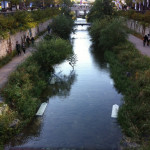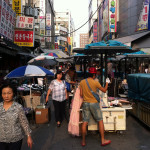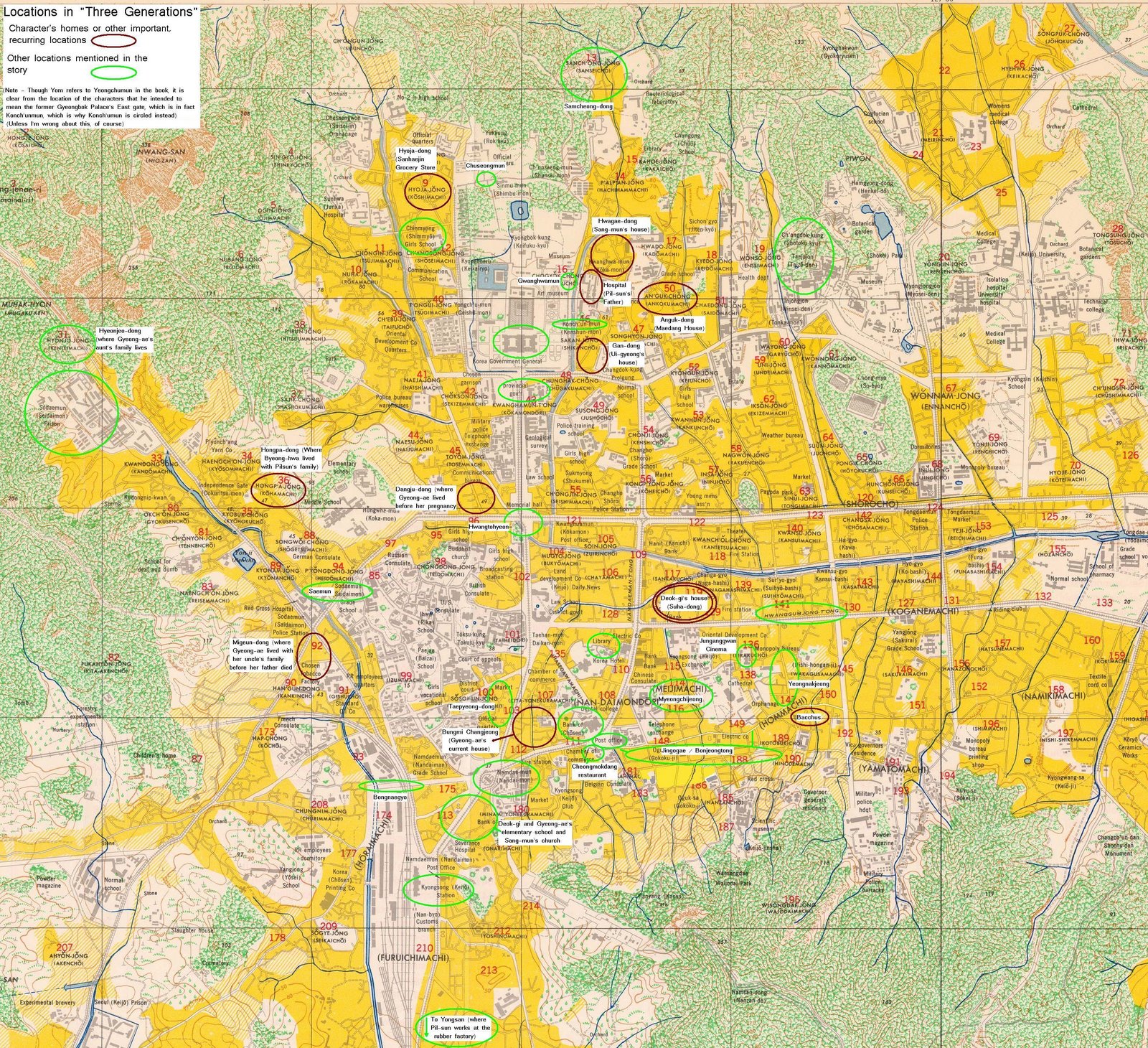I am working on an incredibly exciting project with my colleague Pekka Ihanainen that I won’t go into detail about as it is still under development, but this post is more about a byproduct of those conversations that is outside the scope of the project. I just thought it represented a decent example of a kind of game-based mobile learning activity that can be conducted in an urban landscape. I may or may not try it in the spring semester of 2014 with my students. Basically, it involves taking a seminal work in a particular context, in this case the novel Three Generations by Yom Sang-Seop (염상섭), and localizing it in an urban landscape. The book was published in 1931 and chronicles the plight of a family under the Japanese colonial regime. It is also highly rooted in a geographical landscape, repeatedly mentioning place names and landmarks, not unlike Joyce’s Ulysses. As such, it is a perfect backdrop for a field-based mobile learning activity as it can positioned with some accuracy in physical space.
The reflective and analytical activities surrounding the work are translated into field based activities. Participants are assigned locations, or chapters that are rooted in locations, they generate a cursory analysis, translate that analysis into objects for a virtual geocache, generate the geocache and the hints to find it, students find it, add to it, log their discoveries, and someone ‘wins.’
I got this idea from a blog that I follow, Gusts of Popular Feeling, that had discussed the possibility of finding the modern place names for those mentioned in the book (Seoul has changed a lot since then). He translated it into a walking tour of old Keijo (the Japanese imperial name for Seoul). I think it could be translated into a game-based activity. Below I outline how.
Lesson Plan
Location: Seoul, Korea
Focus: Three Generations by Yom Sang-Seop
Background: considered one of Korea’s most important works of fiction, Three Generations charts the tensions in the Jo family in 1930s Japanese occupied Seoul. The novel reveals the country’s situation under Japanese rule, the traditional Korean familial structure, and the battle between the modern and the traditional. Further, the entire novel is mapped to a particular location in Seoul, not unlike Joyce’s Ulysses, making it ideal for a geographical exploration of a particular discipline.
Purpose
- Explore a classic work of Korean literature
- Analyze that work for its significance to modern Korean life and history
- Associate locations in Seoul in the traditional (1931) to the modern (2013) during and after the Japanese colonial period
- Combine traditional text-based analysis with other forms of media; attempting to generate multimedia literacies and presentation skills
- Generate media in the selected locations
- Generate an activity that envelopes both formal (disciplinary) and informal learning (gaming) activity.
Activities
- Students read the novel
- Students are paired into teams (of their own choosing)
- Students identify a particular passage they want to analyze (rooted in a particular place)
- Students reflect on this passage
- Students map text to media (and generate media to represent sections of the passage or chapter)
- Teams create a virtual geocache of materials related to this passage (including their own reflections). The teacher logs all the caches and their contents.
- Teams embed the virtual cache in a particular location, identify the coordinates of the location and create hints to help the other teams find it. The hints could be visual impressions of the location (a street sign, a nearby building, an audio recording of the traffic). The teams send the coordinates and the hints to the teacher. The teachers loads the hints onto a centralized site for all to see.
- Teams find the other caches, reflect on the significance of their location and contents, record the coordinates, and transmit all of that to the teacher.
- Lessons learned and reflective session cataloging all the media and the additions to the respective caches.
Map of Seoul (1945) with Japanese place names as they would have appeared in the novel The Three Kingdoms. Circled sections include the locations of several passages of the novel. (Gusts of Popular Feeling, 2013).
There is much more that would go into this than I suggest here. There would be considerable logistical planning necessary, including an inventory of what mobile technology is readily available (as this would be a virtual cache). Yet, I think it is incredibly rich pedagogically. Urban landscapes are perfect for this sort of exploration as they engage the learner on a host of levels, from sensory to aesthetic to intellectual to emotional. A multitude of alignments and vantage points are present, a multitude of media assemblies and modes of analysis. I will generate more detail if and when I actually conduct the activity, but I am including a few sources below in case anyone wants to explore further.
For those who might think geocaching is sort of antiquated, it isn’t. It still engages the learner in a geospatial and disciplinary exploration of meaning across time and space. It still games as much as possible many of the learning activities involved in an exploration of literature or art. It is still a highly relevant (and highly accessible) learning activity.
Bibliography
- Chavez, D. J., Schneider, I., & Powell, T. (2004). The social-psychology of a technology driven outdoor trend: Geocaching in the USA. In Proceedings of HICSS.
- Farman, J. (Ed.). (2013). The Mobile Story: Narrative Practices with Locative Technologies. Routledge. Farman, J. (2011). Mobile interface theory. Routledge.
- Farman, J. (2009). Locative life: Geocaching, mobile gaming, and embodiment. Geocaching (2013). Retrieved November 22, 2013 from http://www.geocaching.com.
- Gram-Hansen, L. B. (2009, April). Geocaching in a persuasive perspective. In Proceedings of the 4th International Conference on Persuasive Technology (p. 34). ACM.
- Gusts of Popular Feeling (2006). The Three Generations’ Keijo Walking Tour. Retrieved November 23, 2013 from http://populargusts.blogspot.kr/2006/11/three-generations-keijo-walking-tour.html.
- Hooper, C. J., & Rettberg, J. W. (2011). Experiences with geographical collaborative systems: Playfulness in geosocial networks and geocaching. Google (2013). Ingress. Retrieved November 23, 2013 from http://www.ingress.com.
- O’Hara, K. (2008, April). Understanding geocaching practices and motivations. In Proceedings of the SIGCHI Conference on Human Factors in Computing Systems (pp. 1177-1186). ACM.
- Opencaching (2013). Retrieved November 20, 2013 from http://www.opencaching.com/en/.
- Schlatter, B. E., & Hurd, A. R. (2005). Geocaching: 21st-century hide-and-seek. Journal of Physical Education, Recreation & Dance, 76(7), 28-32. World Economic Forum, 2011. Retrieved November 20, 2013 from http://www.weforum.org.
- Yom Sang-Seop (1931). Three Generations. Retrieved November 21, 2013 from http://www.amazon.com/Three-Generations-Yom-Sang-Seop/dp/097785762X.











[…] so. It has been field tested in some configuration many times by the organisers (Edinburgh, Bremen, Seoul, Helsinki, Amsterdam, London, New York, and […]